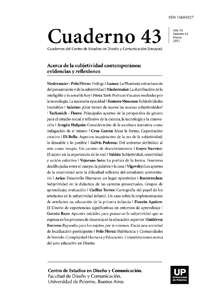Idear la forma. Capacitación creativa
Abstract
Beyond all that gathers us, creativity is an aspect of our thinking that we can define as creative subjects, and which is reflected in specific disciplines of human endeavor. For the designer is a key tool for new solutions, and the project action, it is the ability to conceive, imagine, intuit solutions, to the point where we can identify a person as a creative agent. From the drawing, in this article, we present some methods developed to train and provide to the subject some skills that allow creativity to be present in the design creative action.
References
Ballesteros, S. (2002). Psicología General. Atención y Percepción. Madrid: Universidad Nacional de Educación a Distancia.
Bayo, J. (1987). Percepción, desarrollo cognitivo y artes visuales. Barcelona: Editorial Anthropos.
Gil, M. del C. (1993). La construcción del espacio en el niño a través de la información táctil. Madrid: Editorial Trotta. y ONCE.
Guilford, J. P. (1950). Creativity. American Psychologist. 5, 444 – 454.
Luria, A. R. (1984). Sensación y percepción. Barcelona: Martínez Roca.
Maris, C. (2004). Cómo dibujar. Guía completa de sus técnicas e interpretación. Madrid: H. Blume.
Ballesteros, S. (2002). Psicología General. Atención y Percepción. Madrid: Universidad Nacional de Educación a Distancia.
Bardisa, L. (1992). Cómo enseñar a los niños ciegos a dibujar. Madrid: ONCE.
Bayo, J. (1987). Percepción, desarrollo cognitivo y artes visuales. Barcelona: Editorial Anthropos.
Cruz, C. (2006). Un modelo háptico de dibujo artístico para diseño industrial. Metodología para la ideación y creatividad. Actas de Diseño 1. Buenos Aires: Universidad de Palermo: 215, 216.
De la Torre, S. (1995). Creatividad aplicada. Recursos para una formación creativa. Madrid: Escuela Española.
Gardner, H. (1995). Mentes creativas. Una anatomía de la creatividad humana. Barcelona: Paidos.
Gil, M. del C. (1993). La construcción del espacio en el niño a través de la información táctil. Madrid: Editorial Trotta. y ONCE.
Gibson, J. J. (1974). La percepción del mundo visual. Buenos Aires: Infinito.
(1962). Observations on active touch. Psychological Review. Número 69. 477– 491.
Guilford, J. P. (1950). Creativity. American Psychologist. 5, 444 – 454.
Kennedy, J. M. (1997). Así dibujan los ciegos. Investigación y Ciencia, Marzo, Número 246, 52-58.
Luria, A. R. (1984). Sensación y percepción. Barcelona: Martínez Roca.
Maris, C. (2004). Cómo dibujar. Guía completa de sus técnicas e interpretación. Madrid: H. Blume.
Varios (Coord. Cruz, C y Prieto, J. A.) (2011). Diseñando con las manos. Proyecto y proceso en la artesanía del siglo XXI. Madrid: FUNDESARTE.
Los autores/as que publiquen en esta revista ceden los derechos de autor y de publicación a "Cuadernos del Centro de Estudios de Diseño y Comunicación", Aceptando el registro de su trabajo bajo una licencia de atribución de Creative Commons, que permite a terceros utilizar lo publicado siempre que de el crédito pertinente a los autores y a esta revista.


